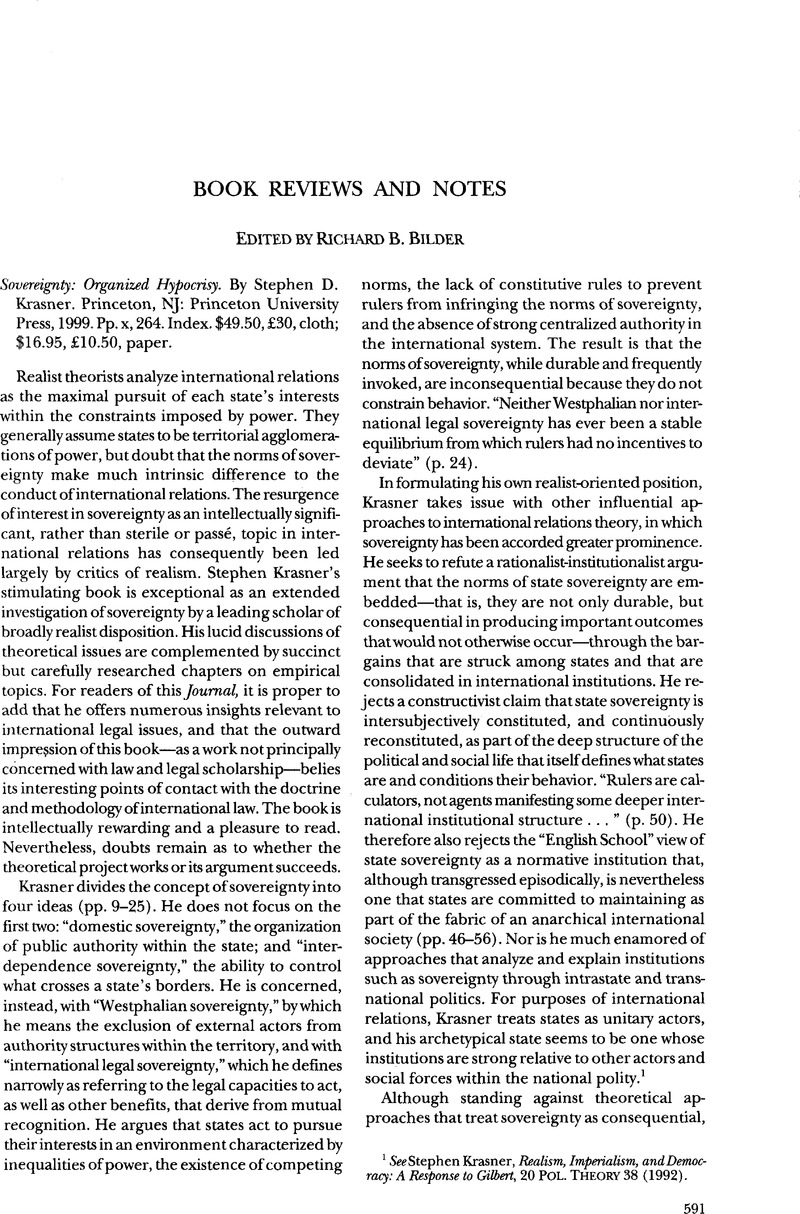Article contents
Sovereignty: Organized Hypocrisy. By Stephen D. Krasner. Princeton, NJ: Princeton University Press, 1999. Pp. x, 264. Index. $49.50, £30, cloth; $16.95, £10.50, paper.
Published online by Cambridge University Press: 27 February 2017
Abstract

- Type
- Book Reviews and Notes
- Information
- Copyright
- Copyright © American Society of International Law 2000
References
1 See Krasner, Stephen, Realism, Imperialism, and Democracy: A Response to Gilbert, 20 Pol. Theory 38 (1992)CrossRefGoogle Scholar.
2 Brunsson, Nils, The Organization of Hypocrisy: Talk, Decisions and Actions in Organizations (1989)Google Scholar. Krasner utilizes several ideas developed by Brunsson, as well as James March, Johan Olsen, and other organization theorists.
3 Brunsson refers to hypocrisy as “inconsistency between talk and action, presentation and results,” id. at 205, but does not privilege action or results as against talk or presentation. He describes the relations among these modes as involving complex interactions. Id.
4 This analysis has been forcefully presented in Moravcsik, Andrew, The Origin of International Human Rights Regimes: Democratic Delegation in Postwar Europe, 54 Int’l Org. 217 (2000)CrossRefGoogle Scholar. The example concerning the European Convention on Human Rights (ECHR) perhaps should have given Krasner greater pause, however. Some rulers viewed the ECHR as at least potentially consequential, and the subsequent impact of the ECHR institutional structure suggests that they were correct. If that institution has been consequential, why not sovereignty?
5 See, e.g., John, Gerard Ruggie, Territoriality and Beyond: Problematizing Modernity in International Relations, 47 Int’l org. 139 (1993)Google Scholar; Katzenstein, Peter, Conclusion to The Culture of National Security: Norms and Identttyin World Politics 518 (Katzenstein, Peter ed., 1996)Google Scholar.
6 See Maccormick, Neil, Legal Reasoning and Legal Theory (1978)Google Scholar.
7 See, e.g., Meyer, John W., Boli, John, Thomas, George M., & Ramirez, Francisco O., World Society and the Nation State, 103 AM.J. Soc 144 (1997)CrossRefGoogle Scholar.
8 For a thoughtful integration of norms into an institutionalist legal theory and a theory of the state— which is then used as a platform for analysis of developments in the movements for European union and Scottish autonomy or independence, see Neil Maccormick, Questioning Sovereignty (1999).
9 On norms and institutions, see, e.g., Kornhauser, Lewis, Three Roles for a Theory of Behavior in a Theory of Law, Rechtstheorie (forthcoming 2000)Google Scholar. My discussions both with Kornhauser and Andrew Hurrell have been especially helpful on questions involving norms and institutions (as well as on other issues considered herein).
10 In Sovereignty, International Relations Theory, and International Law, 52 Stanford L. Rev. 959, 967 (2000)Google Scholar Jack Goldsmith asserts that “Westphalian sovereignty, defined as ‘the exclusion of external actors from domestic authority structures,’ has been a fundamental norm of international law since at least the middle of the eighteenth- century.” The term “norm” is presumably not intended by Goldsmith to mean “legal rule,” but if it is, his claim would be a remarkably broad one. Goldsmith adds that most international lawyers “think violations of sovereignty to protect individual rights is a late-twentieth-century development,” id. at 968. If international lawyers have, indeed, been laboring in the grip of such propositions, Krasner’s book will come as a much needed revelation. International law doctrine has generally been much closer to the complex and often messy body of practice that Krasner chronicles.
11 See discussion supra at 591.
12 Michael Reisman, W., Introduction to Jurisdiction in International Law, at xiv (Michael Reisman, W. ed., 1999)Google Scholar.
13 Oppenheim, Lassa, International Law (1905–1906)Google Scholar.
14 See, e.g., King, Gary, Keohane, Robert O., & Verba, Sidney, Designing Social Inquiry 38 (1994)Google Scholar.
15 A defense of sovereign equality against some such challenges is offered in Kingsbury, Benedict, Sovereignty and Inequality, 9 Eur. J. Int’l L. 599 (1998)CrossRefGoogle Scholar.
16 Krasner, Stephen, International Law and International Relations: Together, Apart, Together? 1 Chi. J. Int’l L. 93, 99 (2000)Google Scholar.
17 Oppenheim, Lassa, The Science of International Law: Its Task and Method, 2 AJIL 313 (1908)CrossRefGoogle Scholar; International Law Essays (McDougal, Myres & Michael Reisman, W. eds., 1981)Google Scholar; Haas, Ernst, Nationalism, Liberalism, and Progress (1997)Google Scholar; Wendt, Alexander, Social Theory of International Politics (1999)CrossRefGoogle Scholar.
18 Krasner, Stephen, Wars, Hotel Fires, and Plane Crashes, 26 Rev. Int’l Stud. 131, 136 (2000)Google Scholar.
- 3
- Cited by




